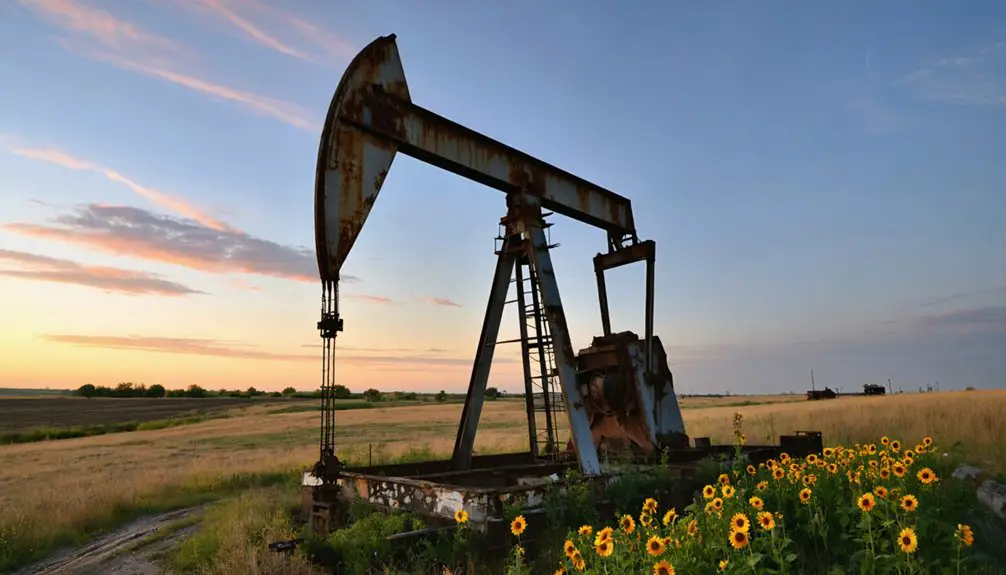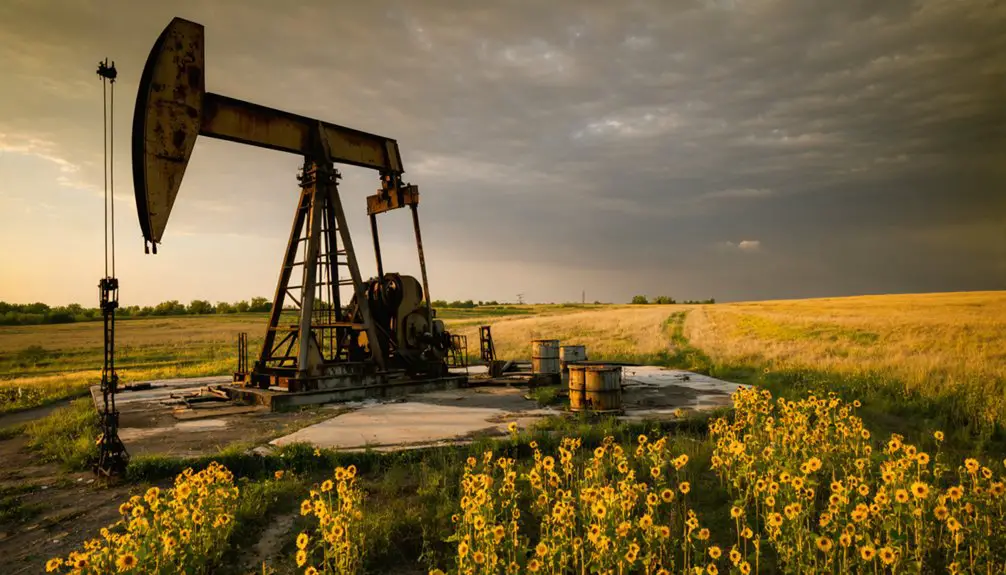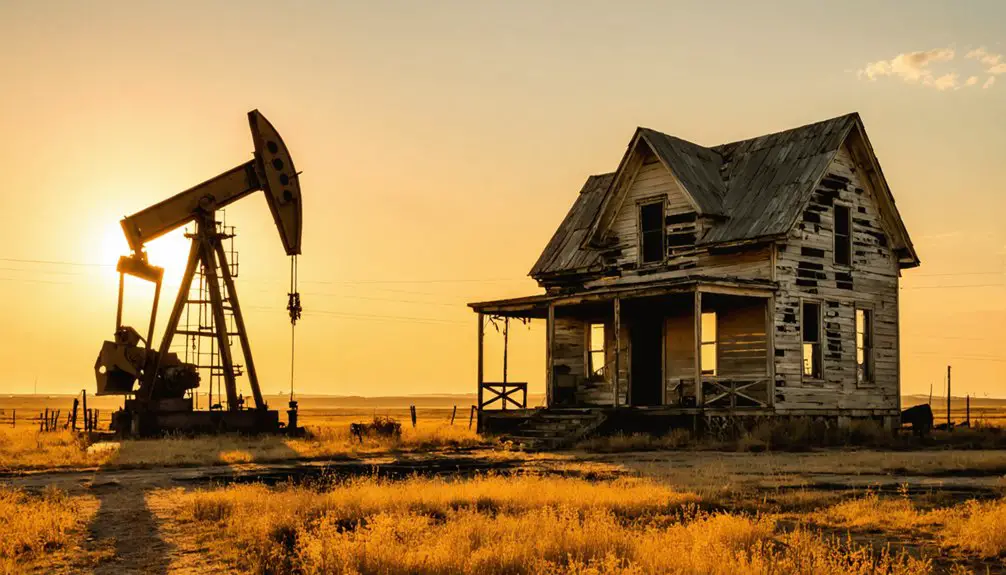You’ll discover Oil Hill’s remarkable story as one of Kansas’s most significant ghost towns, established in 1915 by Cities Service atop the El Dorado Oilfield. At its peak, this company town housed 8,000 residents and featured modern amenities like swimming pools, tennis courts, and a golf course. The town thrived until oil production declined, leading to its eventual abandonment, marked by the post office’s closure in 1958. The site holds fascinating tales of boom-era Kansas.
Key Takeaways
- Oil Hill was established in 1915 by Cities Service atop the El Dorado Oilfield, growing to 2,500 residents during Kansas’s oil boom.
- The company town featured shotgun houses, medical facilities, and recreational amenities including swimming pools, tennis courts, and a golf course.
- At its peak, Oil Hill housed 8,000 residents and was completely controlled by Cities Service, managing all homes, stores, and businesses.
- The town declined when oil jobs disappeared, with the post office closure in 1958 marking a significant milestone in its transformation.
- Today, Oil Hill exists as a ghost town with few original structures, though its history is preserved through photographs at Wichita State University.
The Birth of a Boomtown
When Cities Service established Oil Hill in 1915 atop the newly discovered El Dorado Oilfield, they couldn’t have predicted how quickly their company town would transform into a bustling hub of 2,500 residents.
You’d have found a meticulously planned community springing up almost overnight, with shotgun-style houses and machine shops dotting the landscape. Doctor offices and clinics provided essential medical care for the growing population.
The oil industry’s demands shaped every aspect of daily life. You’d see workers heading to their “tours” at the drilling rigs operating round-the-clock, while community dynamics revolved around shared employment at Cities Service. Butler County experienced a dramatic change as population doubled by 1920 due to the oil boom.
The town’s infrastructure included everything you’d need – from grocery stores and barber shops to recreational facilities like a swimming pool and tennis courts.
It was a self-contained world where the rhythm of life pulsed with the heartbeat of the El Dorado oil boom.
Peak Years of Black Gold
As oil production from the El Dorado field reached staggering levels in 1918, you’d witness Butler County pumping nearly 29 million barrels annually – representing about 9% of America’s total output.
From the initial oil discovery, wells across the region yielded impressive numbers, with some gushing up to 750 barrels daily, while most averaged between 200-300 barrels from the upper sand layers at 1,400 feet.
Wells unleashed immense wealth from El Dorado’s upper sand layers, gushing hundreds of barrels daily from 1,400 feet below ground.
That same pivotal year saw Kansas achieve its highest-ever production with 45 million barrels statewide.
You could find wells systematically spaced 660 feet apart on 100-acre plots, maximizing extraction across the landscape.
By 1929, Butler County had produced an astounding 200 million barrels.
The Skelly Oil Company emerged as a major player in 1917, eventually becoming the largest refinery in Kansas with a daily capacity of 25,000 barrels.
However, the glory days wouldn’t last forever. Production decline set in, and by 1934, wells averaged just 5.4 barrels per day, signaling the beginning of the end for this remarkable boom period.
Life in a Company-Owned Settlement
During the height of the oil boom, Oil Hill stood as one of the world’s largest company towns, with Cities Service (now Citgo) maintaining complete control over its more than 8,000 residents.
You’d find every aspect of life under company control – from the homes you’d live in to the stores where you’d shop. The 24-hour drilling operations shaped daily routines, with round-the-clock businesses supporting night shift workers.
You’d spend your free time at company-provided amenities like swimming pools, tennis courts, and a golf course – luxuries rare for company towns of that era. The development was made possible by southeastern Kansas coal that initially powered the region’s growth.
The welfare hall served as your entertainment hub, fostering community cohesion among neighbors who shared not just a workplace but an entire way of life.
This unified workforce created strong social bonds, though you’d have few options outside the company’s carefully crafted ecosystem.
The town emerged following the El Dorado Field discovery in 1915, which became America’s largest single oil producer by 1918.
Economic Impact on Butler County
The discovery of oil near El Dorado in the early 20th century released an unprecedented economic transformation across Butler County. You’d have witnessed the county’s population doubling within a decade as oil exploration brought thousands of workers and their families to the region.
By 1918, the El Dorado oil field was producing nearly 9% of America’s total oil output.
The boom’s ripple effects touched every corner of the local economy. Oil Hill alone grew to house over 8,000 residents, while pioneering companies like Cities Service and Gulf Oil established operations that sparked economic diversification.
Economic growth surged through Butler County as Oil Hill swelled and major petroleum companies fueled widespread development across industries.
You’d have seen new jobs emerge not just in drilling and refining, but across manufacturing, transportation, and retail sectors. The wealth generated supported infrastructure development and created a lasting foundation for Butler County’s future growth.
Daily Life During the Oil Rush
If you’d lived in Oil Hill during the oil rush, you’d have likely resided in one of the hastily-built shotgun houses while working exhausting round-the-clock shifts at the oil fields.
Your daily routine would’ve revolved around the demanding “tours” at the drilling sites, where the constant noise of pumping machinery and derricks formed the backdrop to your workday.
After your shift, you might’ve joined fellow workers at the local drugstore or saloon, which stayed open late to accommodate the 24-hour work schedule of the bustling boomtown.
The town experienced an unprecedented population surge as Butler County grew from 23,000 to 43,000 residents between 1910 and 1920.
With over 8,000 residents at its peak, Oil Hill thrived as a company town where nearly everyone worked for the oil industry.
Housing and Living Conditions
Living conditions in Oil Hill reflected the stark realities of a company-controlled boomtown, where workers faced severe housing shortages despite the community’s notable amenities.
You’d find yourself competing for limited housing options, often resorting to temporary accommodations like RVs, trailers, or rented yards. Similar to modern oil communities experiencing high home prices, availability was a constant challenge. While the town boasted unusual luxuries for a boomtown – including a swimming pool, tennis courts, and a small golf course – you couldn’t own your home. The company maintained strict control through leasing arrangements, and workers viewed their stay as temporary.
The housing crisis forced many to tap into existing utilities without proper arrangements, leading to overcrowded conditions and infrastructure strain. Modern-day Kansas residents still deal with similar challenges as oil industry encroachment continues to impact local communities.
When the boom ended, these company-owned houses were quickly dismantled and relocated, leaving little trace of the once-bustling community.
Workers’ Daily Routines
Workers at Oil Hill faced grueling 24-hour operations that dominated every aspect of their daily routines.
You’d find yourself working challenging shifts called “tours,” handling physically demanding tasks in Kansas’s extreme weather conditions. Whether you were a driller, pumper, or refinery worker, your role required constant attention to keep the oil flowing day and night.
- You’d brave intense heat or cold while operating heavy machinery like derricks and pumpjacks.
- Your shift might require maintaining equipment, monitoring well pressures, or processing crude oil.
- You’d rely on local businesses that stayed open 24/7 to support your non-traditional schedule.
- You’d face routine hardships including dangerous conditions, minimal safety gear, and exposure to noise and pollution.
Living in nearby shotgun houses, you’d remain close to the demanding work that defined Oil Hill’s boom years.
Social Activities After Work
Despite the demanding work schedules, Oil Hill’s social scene buzzed with activity as you’d find plenty of recreational options to fill your after-shift hours.
You could swim at the community pool, play tennis, or enjoy a round of golf at the small course. Social gatherings at the soda fountain or company-sponsored halls gave you chances to unwind with fellow workers.
You’d catch regular entertainment at local theaters, join community events like dances and holiday celebrations, or participate in sports tournaments.
Churches and social clubs organized activities while informal get-togethers, from potlucks to storytelling sessions, strengthened neighborhood bonds.
Whether you preferred structured recreation or casual meetups, Oil Hill’s company-funded facilities and active social networks guaranteed you’d always find ways to relax and connect after work.
The Stapleton Well Legacy

You’ll find the Stapleton #1 discovery‘s true importance in how it transformed Kansas from farmland to an energy powerhouse, marking the first scientifically-placed oil well in the region’s history.
The well’s initial flow of 150 barrels per day in 1915 sparked an unprecedented rush that established over 1,800 producing wells by 1919 in Butler County alone.
Through the decades following Stapleton’s breakthrough, the El Dorado Oil Field yielded more than 300 million barrels of oil, cementing Kansas’s position as the nation’s fifth-largest oil producer by 1925.
Breakthrough Discovery Changes Kansas
The 1915 discovery of Stapleton #1 revolutionized Kansas oil exploration when Cities Service struck oil using geological science for the first time in the state’s drilling history.
This geological innovation, led by “Daddy” Haworth’s precise mapping and structural analysis, transformed the region’s economic landscape.
You’ll find the impact of this breakthrough reflected in El Dorado field’s remarkable 300-million-barrel production legacy and Butler County’s emergence as Kansas’s top oil producer.
- Scientific mapping identified productive areas with unprecedented accuracy, hitting oil on nearly every targeted acre.
- The discovery accelerated Kansas’s shift from horse-drawn transportation to the gasoline age.
- Stapleton #1’s success at 2,497 feet sparked the development of Kansas’s most prolific oil field.
- The breakthrough established geological surveying as the industry standard, ending the era of guesswork drilling.
Historical Production Records
Stapleton #1’s remarkable production legacy began with an estimated 14,000-barrel daily output that helped establish El Dorado as Kansas’s most prolific oil field.
Throughout its 222-day flowing life, you’ll find this pioneering well produced an astounding 2.5 million barrels, utilizing production techniques that included strategic well interventions to maintain output.
When you look at the broader impact, Butler County’s oil production soared to unprecedented levels.
By 1917-18, the El Dorado field was pumping over 100,000 barrels daily, with some wells reaching 15,000 barrels.
The field’s success led to over 4,100 wells by 1934, generating 232.9 million barrels worth approximately $465 million.
Even as production naturally declined, the field’s total output eventually exceeded 300 million barrels, cementing its place in Kansas oil history.
From Prosperity to Abandonment
Following the discovery of significant oil reserves in Butler County around 1915, Oil Hill rapidly transformed from empty plains into a bustling hub of activity.
The town’s lack of economic diversification and complete dependence on oil would later prove fatal to its community resilience. As production declined and companies relocated, you’d have witnessed the gradual exodus of residents seeking opportunities elsewhere.
Oil Hill’s fate was sealed by its singular focus on petroleum, leaving a vulnerable community that crumbled when the wells ran dry.
- The post office’s closure in 1958 marked a symbolic end to Oil Hill’s vibrancy
- Workers and their families departed as oil-related jobs disappeared
- Local businesses and homes fell into disrepair or were dismantled
- The town’s strategic importance diminished as nearby communities grew
Today, you’ll find few traces of the once-thriving settlement, though Oil Hill Elementary School preserves the name of this ghost town that played a vital role in Kansas’s oil history.
Preserved Memories and Photographs

If you’re curious about daily life in Oil Hill during its peak years, you’ll find rich documentation in the historic photographic collections preserved at Wichita State University Library’s Special Collections.
These vintage photographs capture the essence of the oil boom era through images of workers, boarding houses, and bustling town scenes from the early 20th century.
The visual records offer detailed glimpses of the town’s infrastructure, including housing and community buildings that supported the once-thriving oil industry.
Historical Photo Collections
The preservation of Oil Hill’s visual history finds its home in several important archives, with Wichita State University Library hosting the most extensive collection of photographs from this former oil boom town.
The photographic preservation efforts span from 1917 to 1958, documenting the town’s rise and eventual transformation into a ghost town. You’ll find these collections essential for understanding the economic and social dynamics of early 20th-century oil boom communities.
- Industrial scenes featuring drilling rigs, pump jacks, and company operations
- Daily life snapshots showing company-owned homes, stores, and community spaces
- Transportation infrastructure including rail connections and oil shipment facilities
- Aerial views and landscapes placing Oil Hill within Butler County’s geographic context
The ghost town documentation continues through digitization initiatives, making these valuable records accessible to researchers and history enthusiasts alike.
Documenting Daily Life
Beyond the formal archives, personal photographs and memories paint a vivid picture of daily life in Oil Hill during its peak years from 1917 to the late 1950s.
You’ll find stories of oil workers rising early for dangerous field work, while their families managed daily chores in makeshift homes that dotted the bustling landscape. The post office served as a central hub where you’d catch up on local news and collect mail, while community gatherings often centered around church services and social events that strengthened bonds between neighbors.
Through preserved oral histories, you can glimpse the determination of residents who faced harsh working conditions yet maintained tight-knit community support.
Local museums now safeguard these precious memories, along with artifacts that tell the story of Oil Hill’s brief but significant existence.
Geographic Significance and Location
Located precisely at 37°50′10″N 96°53′08″W, Oil Hill Ghost Town sits among the rolling plains of Butler County, Kansas, southwest of El Dorado.
You’ll find this historic site at an elevation between 1,388 and 1,391 feet, marking its cartographic relevance in the region’s terrain. Its geographic context places it within easy reach of Wichita’s metropolitan area, while maintaining its distinct position in south-central Kansas’s oil country.
- Appears on USGS topographic maps under the El Dorado SW quadrangle
- Strategically positioned near historic railroad routes for oil transport
- Situated among other oil-boom communities like Beaumont and Rock
- Maintains elevation data consistency across multiple mapping sources
The location’s significance stems from its carefully chosen position atop valuable oil reserves that once drew settlers to this Great Plains summit.
Modern Remnants and Heritage
While modern-day visitors will find few original structures remaining in Oil Hill, the town’s heritage lives on through several tangible remnants and commemorative efforts.
You’ll find physical traces of the past scattered across the landscape, similar to nearby Le Hunt’s industrial ruins. The most significant preservation of Oil Hill’s legacy continues through Oil Hill Elementary School, part of Circle USD 375, which proudly carries the ghost town’s name.
The town’s history hasn’t been lost to time, thanks to robust community engagement in maintaining its memory.
You can explore historical photographs and documentation at Wichita State University Library, while local folklore and stories about the oil boom era help keep the town’s spirit alive, connecting modern residents to their region’s fascinating past.
Frequently Asked Questions
What Happened to the Original Buildings and Houses of Oil Hill?
Like forgotten treasures lost to time, you’ll find most original structures crumbled from neglect after oil companies left. Without historical preservation, buildings deteriorated severely, though you can still spot a few dilapidated remnants today.
Were There Any Major Accidents or Disasters During Oil Hill’s Operational Years?
You won’t find records of major oil spills or drilling accidents during Oil Hill’s operational years. Historical data shows the town’s decline was economic rather than disaster-related, with safe cable-tool drilling practices.
How Did Children Receive Education in Oil Hill During Its Peak?
Ever wonder how frontier kids learned their ABCs? You’d find schooling methods included rural one-room schoolhouses with local teachers serving multiple grades, likely supported by oil companies and Butler County’s established school districts.
What Was the Maximum Population Ever Recorded in Oil Hill?
You’ll find that Oil Hill reached 8,000 residents at its peak during the oil boom years, specifically between 1917-early 1920s, when population trends skyrocketed due to Empire Gas & Fuel Company’s operations.
Did Any Famous Oil Tycoons or Businessmen Invest in Oil Hill?
Like wildcatters searching empty plains, you won’t find famous oil tycoons’ footprints in Oil Hill’s story. Historical records show local and regional investors made the oil investments, not nationally influential figures.
References
- https://en.wikipedia.org/wiki/Oil_Hill
- https://www.youtube.com/watch?v=rwxsDJz3n9g
- https://newprairiepress.org/cgi/viewcontent.cgi?article=1082&context=sfh
- https://fromnowhere2nowhere.wordpress.com/2024/04/23/flint-hills-forgotten-towns/
- https://legendsofkansas.com/butler-county-extinct-towns/
- https://www.hmdb.org/m.asp?m=56168
- https://aoghs.org/petroleum-pioneers/kansas-oil-boom/
- https://kansassampler.org/8wondersofkansas-commerce/el-dorado-oil-field
- https://www.biblio.com/book/oil-hill-town-cities-service-built/d/1338615564
- https://www.kgs.ku.edu/Publications/Bulletins/12/06_oil.html



